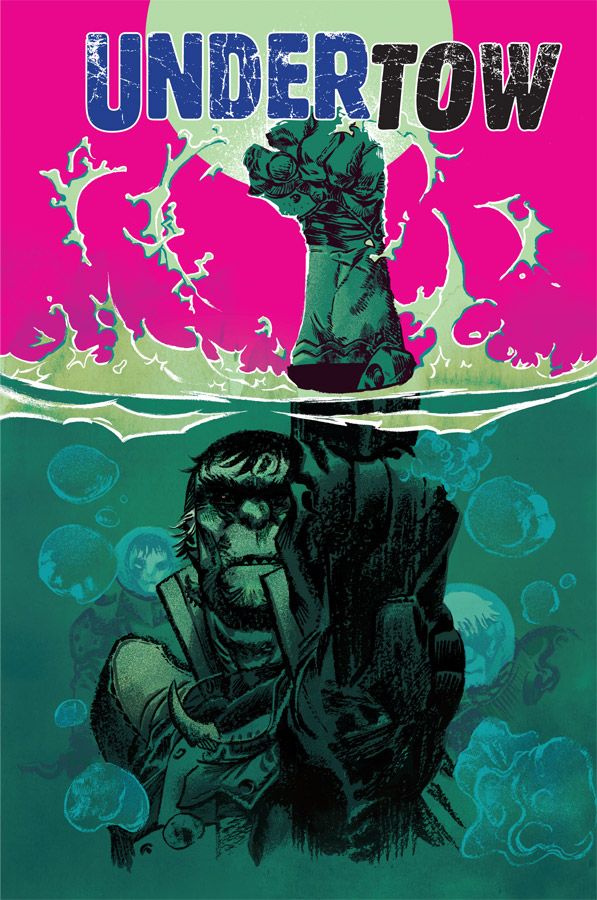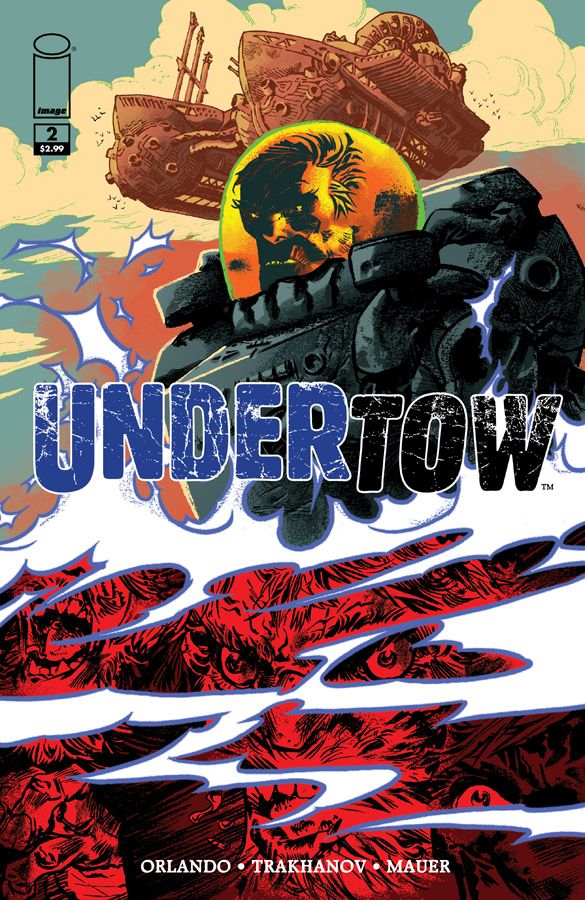Writer Steve Orlando and artist Artyom Trakhanov bring their reimagining of Atlantean legends to Image Comics in February with "Undertow," series which cleverly swaps the roles of Atlantis with dominant continents, placing the citizens of the underwater metropolis as the ruling class. Their opulence and excess has cultivated a complacent lifestyle, with most Atlanteans hardly noticing the world outside of their city. But headstrong Redum Ashargal isn't content with the consumerism and comfort of life in Atlantis; he seeks to liberate the people, to bring them to a higher purpose and to unlock the secrets of breathing air. After recruiting Ukinnu Alal, son of Atlantis' most prominent family, to join his cause, Ashargal sets out to find the Amphibian, a legendary creature thought to possess the secrets of life on land.
With a sprawling story and complex world building taking place, Orlando sat down with CBR to dive deeper into his underwater adventure, divulging a number of the secrets of the legendary city and what readers can expect from the upcoming series.
CBR News: How did "Undertow" end up at Image?
Steve Orlando: "Undertow" came to Image thanks to the magic of New York City Comicon! After my story in "Mystery in Space" in 2012, I hit the show floor with ten complete pages from the book, as well as the cover, and showed it to everyone that asked -- even some that didn't. Eventually, it got in front of Image, and Artyom and I dove into further production. 2013 became the year of "Undertow," as Artyom and I pieced together the remaining nuts and bolds and started to bring this weird underwater show to life.
How did you connect with Artyom?
Artyom and I connected when I discovered his amazing Russian Language webcomic, "Mad Blade." When I lived in Russia I was constantly looking for the comics! I was finally excited, years after I got back, to find some amazing creators doing their thing (and in Artyom's case, in Siberia, way too far away for me to have visited). I emailed him about collaborating, and we put together some short stories, including our revamp of the time travel character Flip Falcon in "Nobodies: Volume 2" from DRAWMORE, INC, which debuted at NYCC '12 the same weekend we connected "Undertow" with Image. After working on the shorts, we wanted to do something more substantial. I mentioned "Undertow," (then called "Tide"), which had been percolating in my brain for years, and he was immediately on board to help create this world.
How large is this story? Do you anticipate it being an ongoing series?
"Undertow" is starting as a 6-issue miniseries, as Anshargal and Ukinnu lead a team on the hunt for the Amphibian, and the Deliverer faces attacks from without and within as the team is gone. The book could definitely continue after the first miniseries; the world is huge, and the characters still have more places to go. The overall arc of Anshargal and his search for the frontier is three acts, three miniseries, but each series is a complete story as well.
"Undertow" is a revisionary story of the legends of Atlantis, bringing it in to modern day as a world power. What was it about Atlantis that you found intriguing? How do you build on a world that is the subject of so many existing theories in pop culture and esoteric science?
Atlantis interests me because of the chance to recreate a society that mirrors ours, but shows us what we take for granted. How much does something simple, like breathing water instead of air, change about a metropolitan life? When Atlantis is usually depicted as a medieval, king and queen world, these questions don't matter quite as much. You don't have to figure out technology, power, media, or modern conveniences. And with the 2/3 of the world the ocean covers, Atlantis has always seemed like it should be a world power to me.
The world building has been pretty low stress! There are a lot of pop culture references to Atlantis, of course, but oddly not many (I would never say not any) that approach it as a modern society. So we have largely felt free to go and do what we want. There are subtle nods to the more archaic Atlantean settings, seahorse rides and the whatnot, but if that happened in our book, it was long ago. These Atlanteans would look at underwater castles and dolphin chariots like we look at the Dark Ages, or more so the Bible or Greek Myth- there's an element of truth, but people debate what actually happened.
The bigger influence was deep-sea biology, the truly weird creatures that seem like science fiction but are just plain fact. When you have creatures adapted for the crushing pressures of the deep, whose bodies cannot even maintain constitution on the surface, you already have a cache of amazing creatures, and biological traits, to extrapolate on.
What are your Atlantian citizens like? What is important to them?
Themselves! Atlantis is a satire of the end result of hyper consumerism, hyper self-centrism. This is a modern nation where the majority is opulent, self-driven, and vapid. Of course there are good people, there are always good people, but largely they are complacent. Their lives are full of first world problems, and as long as they can't see anything bad happening in front of them, they assume all is well and write off any outlying activists as alarmists. If it's not happening to them, then they assume it's not happening. The government, now completely merged with corporate interests, knows this and has entrenched themselves into total power. They control the media, they control the markets, and most people are happy to let it be as long as they're not the ones getting ground under the wheels of the machine.
In the first issue, we see Redum Ashargal appear in battle. What is he like? Why has he become an enemy of Atlantis?
Anshargal is, at this point, like the Clint Eastwood meets Bill Nye of underwater adventure. He's gruff, hard-edged, incredibly intelligent, and incredibly stubborn. He doesn't care what anyone thinks of him, doesn't care that people think he's a terrorist, or that Atlantis hates him. He doesn't care about Atlantis at all, in fact. He only cares about people who want to live differently. Anshargal is like the world's toughest love dad. When it comes to his own people, he cares like it's his job, like it's always on his mind. His dedication to creating a new life for his people is complete. He has worked to become this monolithic leader, reinvented himself, all as a response to what Atlantis did to him.
Years ago he was betrayed by Atlantis, left for dead in the outback reefs, and had to survive on his own long enough to find a way to start again. He has locked up that part of his life, rather than deal with it. Maybe it kills him inside, but he can't let anyone know. Living well, they say, is the best revenge. And no matter what he lost, his best way to get back at Atlantis is to create a new life where it can't reach him. He'll stop at nothing.
Redum liberates Ukinnu Alal and allows him to travel with him on The Deliverer. What does Redum see in Ukinnu?
In Ukinnu, Redum sees an opportunity. Ukinnu's family is famous; he's like the Bruce Wayne, or the Paris Hilton of Atlantis. His rich, uncaring parents have mapped out his entire life for him. Ukinnu escapes his trophy wife by enlisting, hoping to give his family a black eye. But when Redum finds him, Ukinnu takes the chance to further embarrass them by becoming a traitor. Anshargal recognizes Ukinnu as sees recruiting him as a perfect chance to show Atlantis just how far his reach extends, by assimilating one of their favorite sons. So, Ukinnu and Anshargal are really using each other for their own needs, both to get back at Atlantis.
But Anshargal also sees something else in Ukinnu and his story -- he sees a bit of himself, and maybe, someday, a successor.
Redum and his crew seeking the missing element that would allow them to breathe air on land reminded me of classic environmental challenges in the history of exploring -- man developing technology to travel in space, deep oceanic exploration. What is it about the need for knowledge/progress that will compel people to change the essence of how their bodies work to conquer new land?
It's the need to better ourselves! Our drive is to overcome the elements, overcome the frontier. And we invent new suits, new ships, new technology to do so. Like you said, we have ships that go into space, ships that go to the bottom of the ocean. Anshargal has a ship that can go on land, traverse the skies. but it's not enough for a true frontier society. They must be able to live freely on land without landsuits. And more so, this is also about the idea that one generation should leave a better world for the next. Anshargal and his current crew won't be altering their bodies to live on land. They are hunting the Amphibians DNA so that they can use it to give their children, and future generations, a chance to live in open air. They're fighting for their future, and I think this idea is what drives us to overcome our limitations, so that future generations won't face what we did.
You're writing about a civilization that, aesthetically, appears incredibly inhuman and yet their lives are so close to ours. How do to create characters that readers can relate to?
It's the problems! Look at how Game of Thrones changed High Fantasy. Look at Deadwood and the Western. Suddenly genre was mainstream because these characters had problems we related to. They talked like us (or somewhat like us), they swore like us, they were horny like us, they had human needs and human emotions. These weren't archaic problems, these are the same problems we have today. Anshargal and his crew don't look like us, they live in a fantastic world, but no matter you look like or where you live, people are people. Ukinnu is trying to get back at his parents, Anshargal is running away from a tragedy. Anshargal's people just want to live free. They don't just go on giant sloth hunts or invent UV lasers, we see them live together, sleep together, bitch about their lives. Just like us. And then they fight enormous condors with jetpacks.
Did any of the art design factor into developing characters the readers could root for?
It certainly did! I initially had an idea for the world, and laid out some basic needs in the script. The technology was there in words, but Artyom's early designs drove how it evolved. Like me, he was excited to use Apergy, an anti gravity energy mentioned in the 1880s science fiction novel Across the Zodiac, and bring it into the modern day. Once we knew Apergy would be power Anshargal's technology, the way the weapons and machines glow in use came soon after. We knew Anshargal's ship would be enormous and regal, but Artyom suggested the interior resemble the insides of a massive organism, to recall how society functions like a living creature. So the Deliverer began to have enormous metal organs for rooms, and on the outside, it gained statues and open glass observation domes, to show the crew's fetishized love the the open-air world. And a bit of Roman decadence. These ideas definitely grew into new new knowledge about the characters, and how they'd approach their world.
"Undertow" #1 surfaces from Image Comics in February.



